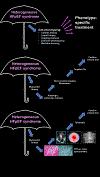Research Priorities for Heart Failure With Preserved Ejection Fraction: National Heart, Lung, and Blood Institute Working Group Summary
- PMID: 32202936
- PMCID: PMC7101072
- DOI: 10.1161/CIRCULATIONAHA.119.041886
Research Priorities for Heart Failure With Preserved Ejection Fraction: National Heart, Lung, and Blood Institute Working Group Summary
Abstract
Heart failure with preserved ejection fraction (HFpEF), a major public health problem that is rising in prevalence, is associated with high morbidity and mortality and is considered to be the greatest unmet need in cardiovascular medicine today because of a general lack of effective treatments. To address this challenging syndrome, the National Heart, Lung, and Blood Institute convened a working group made up of experts in HFpEF and novel research methodologies to discuss research gaps and to prioritize research directions over the next decade. Here, we summarize the discussion of the working group, followed by key recommendations for future research priorities. There was uniform recognition that HFpEF is a highly integrated, multiorgan, systemic disorder requiring a multipronged investigative approach in both humans and animal models to improve understanding of mechanisms and treatment of HFpEF. It was recognized that advances in the understanding of basic mechanisms and the roles of inflammation, macrovascular and microvascular dysfunction, fibrosis, and tissue remodeling are needed and ideally would be obtained from (1) improved animal models, including large animal models, which incorporate the effects of aging and associated comorbid conditions; (2) repositories of deeply phenotyped physiological data and human tissue, made accessible to researchers to enhance collaboration and research advances; and (3) novel research methods that take advantage of computational advances and multiscale modeling for the analysis of complex, high-density data across multiple domains. The working group emphasized the need for interactions among basic, translational, clinical, and epidemiological scientists and across organ systems and cell types, leveraging different areas or research focus, and between research centers. A network of collaborative centers to accelerate basic, translational, and clinical research of pathobiological mechanisms and treatment strategies in HFpEF was discussed as an example of a strategy to advance research progress. This resource would facilitate comprehensive, deep phenotyping of a multicenter HFpEF patient cohort with standardized protocols and a robust biorepository. The research priorities outlined in this document are meant to stimulate scientific advances in HFpEF by providing a road map for future collaborative investigations among a diverse group of scientists across multiple domains.
Keywords: diagnosis; heart failure; precision medicine; therapeutics.
Figures




Similar articles
-
Evaluation of large animal models for preclinical studies of heart failure with preserved ejection fraction using clinical score systems.Front Cardiovasc Med. 2023 Mar 23;10:1099453. doi: 10.3389/fcvm.2023.1099453. eCollection 2023. Front Cardiovasc Med. 2023. PMID: 37034319 Free PMC article. Review.
-
The aging heart in focus: The advanced understanding of heart failure with preserved ejection fraction.Ageing Res Rev. 2024 Nov;101:102542. doi: 10.1016/j.arr.2024.102542. Epub 2024 Oct 12. Ageing Res Rev. 2024. PMID: 39396676 Review.
-
Cellular and molecular pathobiology of heart failure with preserved ejection fraction.Nat Rev Cardiol. 2021 Jun;18(6):400-423. doi: 10.1038/s41569-020-00480-6. Epub 2021 Jan 11. Nat Rev Cardiol. 2021. PMID: 33432192 Free PMC article. Review.
-
Biomarkers in Heart Failure With Preserved Ejection Fraction: An Update on Progress and Future Challenges.Heart Lung Circ. 2020 Jan;29(1):62-68. doi: 10.1016/j.hlc.2019.05.180. Epub 2019 Jul 5. Heart Lung Circ. 2020. PMID: 31311687 Review.
-
Epidemiology and clinical course of heart failure with preserved ejection fraction.Eur J Heart Fail. 2011 Jan;13(1):18-28. doi: 10.1093/eurjhf/hfq121. Epub 2010 Aug 3. Eur J Heart Fail. 2011. PMID: 20685685 Free PMC article. Review.
Cited by
-
Fasting and Post-Load Glucose and Non-Esterified Fatty Acids and Risk of Heart Failure and Its Subtypes in Older Adults.J Gerontol A Biol Sci Med Sci. 2023 Jul 8;78(7):1164-1171. doi: 10.1093/gerona/glac229. J Gerontol A Biol Sci Med Sci. 2023. PMID: 36373954 Free PMC article.
-
Salutary Acute Effects of Exercise on Central Hemodynamics in Heart Failure With Preserved Ejection Fraction.J Card Fail. 2021 Dec;27(12):1313-1320. doi: 10.1016/j.cardfail.2021.04.014. Epub 2021 May 8. J Card Fail. 2021. PMID: 33974969 Free PMC article.
-
Non-invasive assessment of HFpEF in mouse models: current gaps and future directions.BMC Med. 2022 Oct 14;20(1):349. doi: 10.1186/s12916-022-02546-3. BMC Med. 2022. PMID: 36229816 Free PMC article.
-
Right Heart Phenotype in Heart Failure With Preserved Ejection Fraction.Circ Heart Fail. 2021 Apr;14(4):e007840. doi: 10.1161/CIRCHEARTFAILURE.120.007840. Epub 2021 Apr 19. Circ Heart Fail. 2021. PMID: 33866826 Free PMC article. Review.
-
A rat model of metabolic syndrome-related heart failure with preserved ejection fraction phenotype: pathological alterations and possible molecular mechanisms.Front Cardiovasc Med. 2023 Jul 4;10:1208370. doi: 10.3389/fcvm.2023.1208370. eCollection 2023. Front Cardiovasc Med. 2023. PMID: 37469482 Free PMC article.
References
Publication types
MeSH terms
Grants and funding
- R01 DK103056/DK/NIDDK NIH HHS/United States
- U01 HL125175/HL/NHLBI NIH HHS/United States
- P01 HL103455/HL/NHLBI NIH HHS/United States
- R01 AG018915/AG/NIA NIH HHS/United States
- R01 HL104106/HL/NHLBI NIH HHS/United States
- R01 HL098032/HL/NHLBI NIH HHS/United States
- R56 HL136730/HL/NHLBI NIH HHS/United States
- R01 HL132551/HL/NHLBI NIH HHS/United States
- P50 DK096418/DK/NIDDK NIH HHS/United States
- R01 HL126638/HL/NHLBI NIH HHS/United States
- R01 HL134321/HL/NHLBI NIH HHS/United States
- R01 HL140731/HL/NHLBI NIH HHS/United States
- R01 HL128526/HL/NHLBI NIH HHS/United States
- K12 CA090625/CA/NCI NIH HHS/United States
- P01 HL094307/HL/NHLBI NIH HHS/United States
- R01 HL127028/HL/NHLBI NIH HHS/United States
- R61 HL146390/HL/NHLBI NIH HHS/United States
- U24 AG059624/AG/NIA NIH HHS/United States
- R01 HL107577/HL/NHLBI NIH HHS/United States
- R01 HL121510/HL/NHLBI NIH HHS/United States
- U01 HL125205/HL/NHLBI NIH HHS/United States
- R01 HL149423/HL/NHLBI NIH HHS/United States
- R01 AG058969/AG/NIA NIH HHS/United States
- R01 HL118524/HL/NHLBI NIH HHS/United States
- U10 HL110262/HL/NHLBI NIH HHS/United States
- R35 HL135827/HL/NHLBI NIH HHS/United States
- R01 AG045551/AG/NIA NIH HHS/United States
- DP2 HL123228/HL/NHLBI NIH HHS/United States
- R01 HL125886/HL/NHLBI NIH HHS/United States
- P30 AG021332/AG/NIA NIH HHS/United States
- T32 HL110849/HL/NHLBI NIH HHS/United States
- R01 HL133695/HL/NHLBI NIH HHS/United States
- R01 HL144657/HL/NHLBI NIH HHS/United States
- R01 HL117153/HL/NHLBI NIH HHS/United States
LinkOut - more resources
Full Text Sources
Medical

